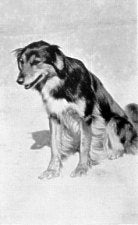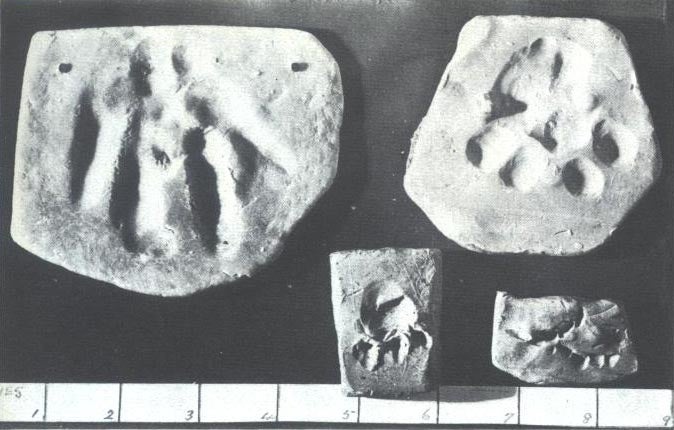It all began on September, 13th 1931, when James claims he saw a creature run across the yard of his farm Doarlish Cashen, known as Cashen’s Gap in Manx Gaelic. Shortly afterwards, the family started to hear something scratching against the wooden panelling, which lined the rooms of the farmhouse for insulation. Thinking they had a rat problem, the family placed traps within the gaps between the panelling and the stone walls of the house, but their prey eluded them. In a last attempt to scare away the pest, James tried growling at it, hoping the noise would be mistaken for a predator, instead the creature growled back. The Irvings quickly discovered that the creature could imitate any animal noise they made, until one day, it started talking and eventually introduced itself as Gef. Once he had started talking, Gef wasn’t very inclined to stop, stating that, “A mongoose can speak if he is taught.” The Irvings claimed Gef spoke with a high-pitched voice, could speak multiple languages and enjoyed repeating nursery rhymes Voirrey taught him or retelling gossip he’d overheard on his jaunts around the island. Gef would often take on the role of a helpful familiar for the family; apparently bringing back small items he found and even killing over a hundred rabbits for them to sell. In return, the Irvings fed him biscuits, sweets and pieces of banana by placing them in his sanctum, which was atop a boxed-in staircase in Viorrey’s bedroom. Despite ingraining himself within the Irving family, Gef was also a trickster. Usually his tricks were harmless, such as the time he awoke the family by moving loudly and banging on the walls. When asked why he was making the noise, Gef exclaimed, “I did it for the devilment!” Other times, however, Gef’s tricks took an aggressive turn. In December of 1931, Voirrey had to move into her parent’s bedroom, because Gef was throwing stones at her whenever she tried to sleep. Upon realising what the Irving’s had done, Gef apparently shouted, “I’ll follow her wherever you move her.” Though Viorrey did eventually return to her bedroom after Gef apologized and promised to never hurt the family, this incident does betray a darker side of Gef’s friendly demeanour. With the rise of psychical research in Britain, Gef soon found himself an audience, becoming known as the Dalby Spook. This publicity led to Harry Price, a paranormal researcher, and Richard S. Lambert, editor of The Listener, visiting the Irvings in July 1935 to investigate Gef. The family’s desire to prove Gef’s existence was hampered, however, by the mongoose himself, who refused to appear for those he deemed “doubters’’ and, unsurprisingly, this included both men. Still, Price and Lambert persisted by exploring investigational avenues that didn’t require Gef’s presence. Before his arrival on the Isle of Man, Price had asked James to send him clippings of Gef’s fur. These were then analysed by F. Martin Duncan, a naturalist, who concluded, “these hairs have probably been taken from a longish haired dog or dogs.” While visiting the farm, Price and Lambert took fur samples from the family’s sheep-dog, Mona. After comparing the two samples, Duncan confirmed that both fur samples came from the same animal. Despite this evidence, Price and Lambert remained unsure on the reality of Gef, with their co-authored book, The Haunting of Cashen’s Gap, concluding with speculation over his existence, rather than a definite yes or no answer. What makes Gef one of the more fascinating cryptids, in my opinion, is that the argument surrounding his existence goes deeper than whether or not he was real, because, if you choose to believe in Gef, then you’re led to ponder over exactly what he was. Was Gef a poltergeist? A tulpa born from the Irving’s collected imagination? A type of fae, like a boggart? Or was he really a mongoose who was born in India during 1852 and brought to the Isle of Man by a farmer trying to control the rabbit population? In the Haunting of Cashen’s Gap, Price reports how the Irving’s described Gef as having fur, “light yellow in colour, long bushy tail (which is also light yellow) and the tail has a black or brown tuft at the extreme end, and there are also, we think, two or three tufts of this brown or black hair on his back.” While I’m not a mongoose expert, this hypothetical creature sounds more akin to the slender mongooses found in sub-Saharan regions of Africa, rather than the Indian grey mongoose. (Sorry Gef.) The easiest way to solve the ‘What is Gef?’ mystery would, of course, have been to simply ask him this question, which, thankfully, the Irving’s did. Unfortunately, Gef was contradictory about his true nature; originally claiming to be “a ghost in the form of a weasel” and “an earth-bound spirit,” only to later decide he was a “little extra, extra clever mongoose.” The logic he gave behind this change was, “I am not a spirit; if I were I could not kill rabbits.” It appears that Gef came to enjoy teasing the family about this subject, telling Margaret, “Of course I know what I am” but she’d “wilt never get to know what I am.” He did later claim to have hands and feet, but refused to confirm if they were corporeal. If Gef was a hoax though, then how was it performed? Some newspapers and researchers at the time claimed Voirrey was a talented ventriloquist, but then we have to answer how a teenager on 1930’s Isle of Man gained such a skill. It seems more likely that one of the Irvings created the noises themselves by hiding in the gaps between the walls and wooden panelling of the house. Yet, it’s never been confirmed whether a person could fit within this space. Gef could have also been a shared delusion born from the family’s isolation on the farm or a family joke that got out of hand, forcing them to maintain the ruse. As the creator of the Bradwell Water-Rabbit, I certainly understand the appeal of imagining such a creature. Interestingly Viorrey continued to claim that Gef existed till she died in 2005. In an interview, one of the few she granted, with Walter McGraw for FATE magazine in 1970 (archived on the Wayback Machine) she stated, “It was not a hoax and I wish it had never happened. If my mother and I had our way we never would have told anybody about it. But Father was sort of wrapped up in it. It was such a wonderful phenomenon that he just had to tell people about it.” It’s important to note that the Irvings never made a profit from Gef’s existence and the farm was eventually sold at a loss due to its reputation for being haunted, so, you have to wonder, if he didn’t exist, why, nearly forty years later, Viorrey would say, “Yes, there was a little animal who talked and did all those thing … do wish he had let us alone.” I was surprised to discover Gef hadn’t starred in a game yet. Compared to other cryptids, which are often simply bizarre creatures like the Loch Ness Monster, Gef is a far more interesting character to explore; we know his likes (biscuits and talking) and dislikes (having his photo taken), not to forget his various claims of knowledge and power - he could split the atom apparently. How about a game where you’re trying to prove his existence and, as you attempt to collect evidence, Gef provides his own brand of assistance. There could even be a game based upon the ‘Talking Mongoose Case’ of 1936. This was when Lambert took Sir Cecil Levita to court for slander after he alleged Lambert was unfit to serve on the board of the British Film Institute for publishing an article about Gef. Lambert won the case and I wish I could have witnessed lawyers arguing over the validity of Gef’s existence. The sinister side of Gef, however, shouldn’t be ignored. Imagine a game akin to Kittyhorrorshow’s Anatomy, where you’re trying to find the creature trapped in the walls of your house. You can hear it scratching and, the further you venture into the house, the louder these sounds become, until you’re met with a voice. The creature claims to be stuck and wants your assistance, but, the more time you spend with it, the harder it becomes to discern the being’s motives. You have to wonder - which one of you is truly trapped? After all Gef did once say, “You don’t know what mischief I could do if I was roused. I could kill you too if I wished, but I won’t.”



